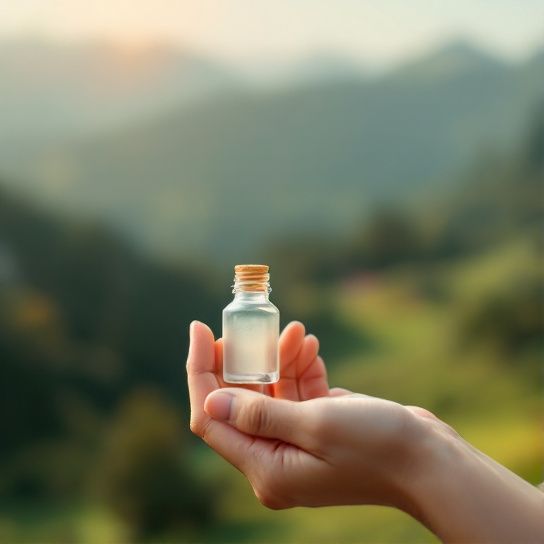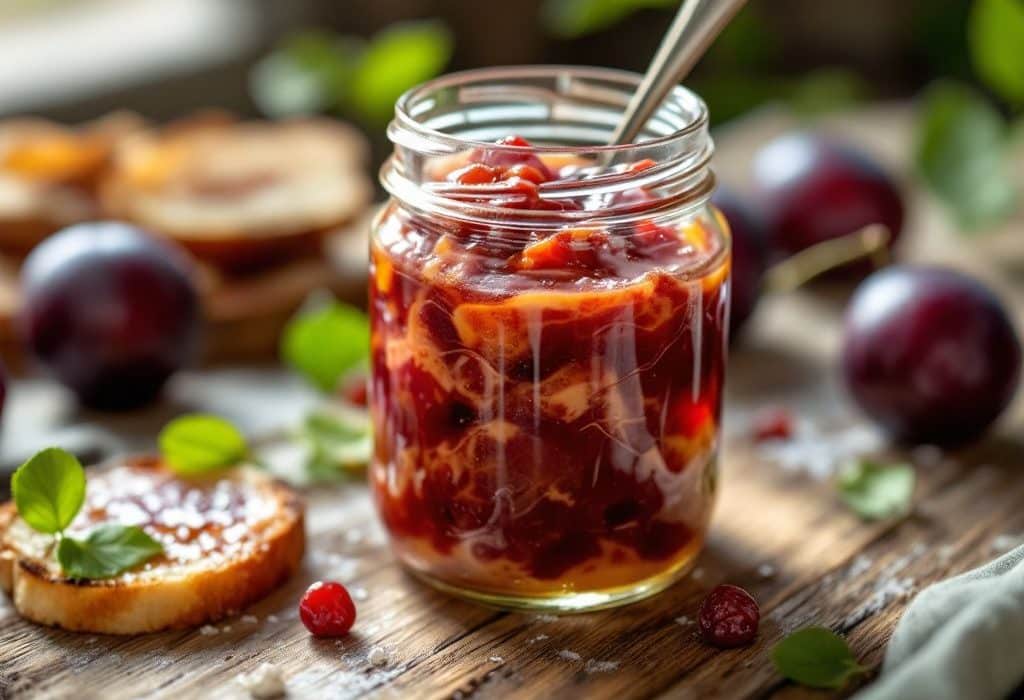Ever find yourself gazing at a basket of plums—ripe and radiant—and wonder what on earth to do with them all? You’re not alone! Fresh fruit, especially plums, has this cheeky habit of ripening all at once. They make tasty snacks, sure, but frankly, how many can you really gobble up before they start taking on new roommates in the form of fruit flies?
Well, let me tell you about something magical called “plum butter.” Yup, it’s like jam’s cooler cousin; smoother, deeply flavored and, if done right, can become the star of your breakfast table. You can spread it on toast or mix it into yogurt—the possibilities are endless. Stick around, and I’ll walk you through it—all while sprinkling in a little wisdom about natural skincare as an extra nugget of goodness.
What Exactly Is Plum Butter?
Now, if you’re scrunching your nose a bit and thinking, “Butter made from plums? Really?” Hold on a sec. Plum butter isn’t some blended concoction of fruit and dairy. Nope, it’s a concentrate of the fruit’s intense flavors—cooked down until it’s silky smooth and perfectly spreadable. Imagine a plum in its essence—sweet, tart, and oh-so-delicious—all in one delicious spoonful. But without the dairy. So, don’t go expecting a buttery texture akin to your unsalted stick, alright?
Why Choose Plum Butter?
It’s a fair question, my friend. Aside from the luxurious texture and robust flavor, plum butter holds up pretty well compared to traditional jams. It cuts down on sugar, relying more on the natural sweetness of the fruit—good news whether you’re minding those calories or just prefer a less sweet start to your day. And if you might be wondering about the peel, the plum skin is a secret powerhouse of flavor and nutrients, so make sure you’re cashing in on that as you churn up your butter.
Keep in mind, it’s not just a condiment—it’s an adventure! Plus, when everyone else is talking about the best jams around, you get to casually drop, “Ever tried plum butter?”
Making Your Own Plum Butter: A Simple Talk-Through
Alright, no need to grab your notebooks just yet. Instead, lean back and let’s stroll through this naturally simple process of crafting your own fruity delight. Just trust me on this.

Getting Your Ingredients Together
What do you really need here that’s not covered in misty-eyed dreams of breakfast tables and spreadable happiness? Seriously, the list is minimal:
- Plums: Naturally. You know the saying, right? Go plum or go home. Around 3-4 pounds should be a good start.
- Sugar: Just a cup or two; adjust this depending on how sweet or tart your plums are.
- Cinnamon: A good pinch (or more if you fancy).
- A squeeze of lemon juice: Helps with acidity balance and keeps that vibrant color intact.
Optional Add-Ins (because why not?)
Feeling a little fancy? These can elevate your plum butter from “nice” to “oh wow”:
- Vanilla extract: A teaspoon or two can bring warmth to the flavor.
- Clove or nutmeg: Adds an autumnal vibrant kick.
On to the Cooking Process!
Time to get a little messy, but in a good way. Here are some chill, straightforward steps to diy-ing this extravaganza:
- Prep Those Plums
Wash ’em good and quarter them. Removing the pit is crucial—unless you enjoy the surprise hit of a solid crunch in what should’ve been a smooth spoonful. Plum skin? Keep it on. It enhances both color and depth of flavor.
- Simmer Stage
Dump those plums into a heavy-bottomed pot—bigger than you think you’ll need because splatters are part of the show—and get them boiling on a medium heat. Add water only if they seem particularly dry, but usually, the fruit will handle this bit for you. Stir often. Simmer about 20 minutes, or until softened.

- It’s in the Blend
Transfer your soft, simmered mix to a blender or food processor and let it do its thing until smooth as jazz and swank.
- ADC (Add, Dissolve, Concentrate)
Pour that silky blend back into the pot, stir in sugar, lemon juice, and your chosen spices. Let it happen over low heat for another 30 to 45 minutes. Thick, rich, and oh, that aroma!
- 5. **The Ultimate Test: The Spoon Chase
When you spoon a dollop onto a plate and it holds firm, it’s done! Transfer to sterilized jars, leave an inch for wisdom’s sake (or is it expansion?). Seal tightly.
Pro Tips for Plum Butter Prowess
Coming at you with love—and a touch of trial and error—are a couple of sweet insights:
- Stir that saucepan! Nothing worse than burnt fruit bringing down the party. So commit to those intervals.
- Taste-test along the way: Adjust sugar or spices more often than you feel necessary.
Embrace the Skin(dare) Opportunity

Now, before I route you off with this plum appeal, here’s a little something to ponder: ever consider using fruit derived ingredients for natural skincare? Picture treating your skin not only to nature’s bounty but actually juicy nutrients. Plum gets a spotlight here, too. The flesh is nice, yes, but the plum skin, packed with antioxidants and vitamin C, dances in the realm of beauty products.
Incorporating Plum into Your Skincare Regimen
The idea is simple, you could derive a natural hydration boost using infusions made from plum skin mixed with standard carrier ingredients you might already have, like coconut oil or shea butter. Want to try a DIY mask? Just simmer leftover skins, strain them to get that natural essence, and mix it into a base. Supports texture, radiance, and overall health—comfort straight from nature to your noggin.
Avoid These Common Pitfalls
Wait…not too easy, surely? It mostly is until distraction invites a classic error. Stay grounded and avoid typical mistakes:
- Skipping on sampling: Tastes evolve, and plum characteristics can vary. Keep a keen palate as the pantry beckons completion.
- Ignoring the vessel: The jar, folks. Make sure they’re sterilized. After all, safety meets deliciousness down the sterility avenue.
Closing the Jar on Your Plum Butter Journey
By now, you’re prepped with a path-steady marched through plum butter know-how. The key takeaway? It’s all about embracing the full fruit. Getting relaxed with its preparation and savoring your creation, all while sneaking insights into natural skincare, that’s the sweet spot right there.
Plum butter, it’s more than a spread. It’s a testament to bright mornings, appreciated harvest, and cozy homemade creations—but more than that, failed to say frequently enough, it’s fun! Blissful breakfasts ahead.Check back, won’t you?
Whatcha’ think? Ready to give this a try, or are you already rummaging for jars? I’m rooting for those taste buds.
Frequently Asked Questions
What are the benefits of using natural skincare products?
Natural skincare products offer several benefits, including being gentler on the skin, reducing the risk of irritation and dryness, and providing nourishment with nutrient-rich ingredients. They are free from harsh chemicals, artificial colors, and fragrances, making them suitable for sensitive skin. Additionally, natural skincare products can help prevent premature aging, contain antioxidant-rich plant extracts, and are more environmentally friendly[1][3][5).
How do natural skincare products differ from conventional skincare products?
Natural skincare products are primarily composed of ingredients derived from plants, animals, or minerals, with minimal or no chemical or synthetic substances. In contrast, conventional skincare products often contain harsh chemicals, preservatives, and synthetic ingredients that can strip the skin of its natural oils and cause irritation. Natural products adhere to stricter standards, such as the absence of pesticides and fertilizers, and are generally more gentle and effective in the long term[1][3][5).
What natural ingredients are commonly used in natural skincare products?
Common natural ingredients in skincare products include coconut oil, shea butter, aloe vera, green tea, chamomile, argan oil, and honey. These ingredients are rich in vitamins, antioxidants, and essential nutrients that promote skin health, reduce oxidative stress, and combat signs of aging. They also offer moisturizing, soothing, and protective qualities that can be tailored to various skin types and concerns[1][3][5).
Are natural skincare products suitable for all skin types, including sensitive skin?
Yes, natural skincare products are often suitable for all skin types, including sensitive skin. They are formulated to be gentle and non-irritating, avoiding harsh chemicals and synthetic ingredients that can cause skin reactions. Natural ingredients like aloe vera, chamomile, and shea butter are particularly beneficial for sensitive skin due to their soothing and moisturizing properties[1][3][5).
References

